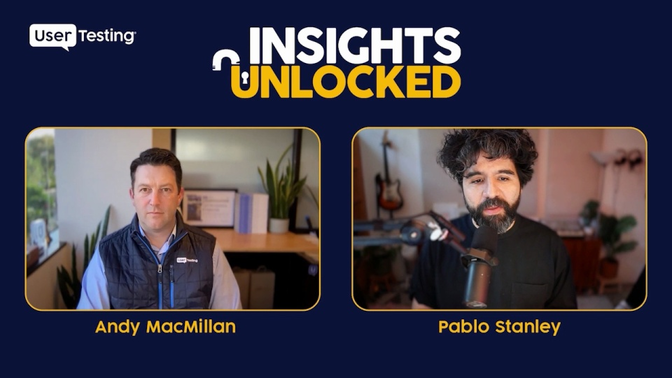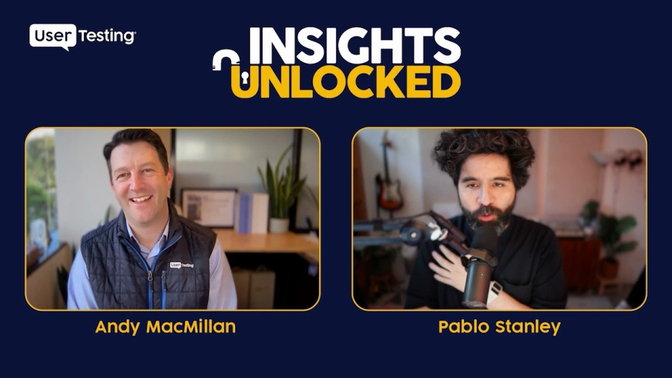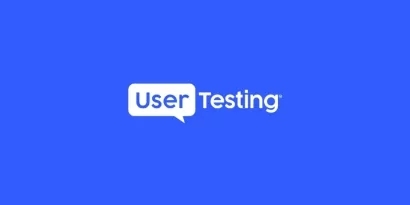
Episode 106 | February 26, 2024
Is AI coming for your design job?
In this episode of UserTesting’s Insights Unlocked podcast, Andy MacMillan talks with Pablo Stanley about AI’s impact on design.
Is AI coming for your design job?
Are you leveraging the power of AI in your creative efforts? Or are the robots coming to take your design job? The answer may be both.
“It's weird because we always thought humans had this unique capability of being creative, and now we realize robots can also be very creative,” said Pablo Stanley on this week’s Insights Unlocked.
Pablo kicks off the new season of the show presented by UserTesting. Other upcoming guests include Don Norman, Teresa Torres, Judd Antin, Jen Romano, Dave Hoya, Chris Messina among others.
Pablo is the founder or co-founder of several design brands, most recently Bueno and the Musho AI plugin for Figma. Previously, he was a lead designer at InVision, as well as a staff designer at Lyft and Udemy. He teaches art and design on his YouTube channel Sketch Together, as well as supports the Latinx community through his projects Latinx Who Design and Dreamer Stories.
In this episode, he talks with UserTesting’s CEO Andy MacMillan about the influence AI will have on design.
“I am a techno-optimist,” Pablo said. “I believe in the potential of these tools to enhance our lives in general and, specifically, that of creative individuals, assisting them in taking their creations to a different level.”

The pace of the change is happening quickly, he said, and some people may get caught in that disruption, including on the creative side, and get left behind.
“It would be naive not to see the challenges this brings,” Pablo said. “The pace of the AI evolution is making traditional systems and industries slow to adapt, sometimes causing an existential crisis. So, there's going to be a transition period where a lot of people will be affected by this shift."
He said designers will need to adapt.
“But at the same time, I see the possibility that design may no longer be a single specialty. These creative AI tools are democratizing creativity,” he said. "The creative output will no longer be just for those with formal training or expensive resources. AI has leveled the playing field for what a designer can achieve.”

But as someone who is building these AI-powered design tools, he said, the comforting thought is that robots aren't very good at design – not yet, at least. “We're working on making them better, by the way!”
He said they're really good at replicating stuff that exists and generating variations of templates, whether designing an email or a website. That's because all the components already exist, so it's just putting them together.
“But in actual coding, layouts, and unique compositions, they're not that great,” he said. “After all, these models draw on existing data, and most of the stuff online isn't great design to begin with, so the output usually isn't either.”
And a lot of repetitive tasks in design have already been reduced thanks to better tools, platforms and design systems – even without AI in the picture.
“With AI, getting rid of these smaller tasks is even easier. The focus should no longer be on pixel perfection – that should be a given when these tools can handle it easily,” he said. “Designers can concentrate on other areas and leverage these little robot assistants to create more of what they envisioned but maybe didn't have the time to do before.”
Overcoming the Dunning-Kruger effect with customer feedback
Pablo speaks candidly about how the Dunning-Kruger effect impacted early development on Musho. This relates to the theme of overcoming bias through testing, admitting gaps in knowledge, and being receptive to how your intended audience actually uses the product.
The Dunning-Kruger effect is a cognitive bias in which the less you know about something the more confident of your abilities on that subject.
After launching Musho, which created a fully designed landing page with just a few text prompts, Pablo and his team thought they would broaden what Musho could design.

“There's even a graphic about the Dunning-Kruger effect and the more confident but the, the less you know, it's also called that the peak of Mt. Stupid,” Pablo said. “And we were at the peak of Mt. Stupid, where we said, ‘OK, let's do it all.”
It was harder than they thought, Pablo said. “But it's been a really nice challenge to have.”
He said getting feedback from users about Musho has been incredibly helpful. “Once we started testing with users it was like, ‘Of course, they need that,’” he said, laughing.
“It's weird because when your working on something; you're building in this little island with your thoughts and all your biases and you think everyone is going to need that perfect very niche product that you created,” Pablo said, smiling. “And then you put it in the hands of your users and they're like, ‘No! you're doing it wrong. Don’t ask it that’…”
Beyond the product: build your entrepreneurial toolkit
Andy asked Pablo what advice he would give to the staff designer that is early in their career and thinking about following an entrepreneurial path like his own.

“Entrepreneurship is truly a rollercoaster ride – you think you've reached the end but realize there's another peak and another freefall right ahead,” Pablo said. “My biggest advice is to embrace the emotional journey because tests come from unexpected places.”
It's a lonely road, Pablo says, and finding a support system is crucial. Surround yourself with like-minded folks who've been there, even consider finding an advisor or other founders with whom to connect.
He also said a co-founder is almost essential to share the workload, bounce ideas off of, and for emotional support during the tough times. Treat them as an equal, he said. Especially in the early stage of idea generation, resist the urge to cling tightly to your initial concept. Pablo recommends a 50/50 split (or equal between multiple technical co-founders); otherwise, you risk resentment down the line.
Remember, he said, at that stage, it's just an idea with statistically low odds.”Why do you want 80% of zero?” he said. Collaborating might improve your chances, and having someone invested beside you makes all the difference.
His final advice is to build resilience for rejection. If you’re not bootstrapping, prepare for lots of 'nos' when approaching VCs. It initially feels personal, but that's not the case. All it takes is one 'yes,' and once the FOMO kicks in, the funding may suddenly get oversubscribed.










